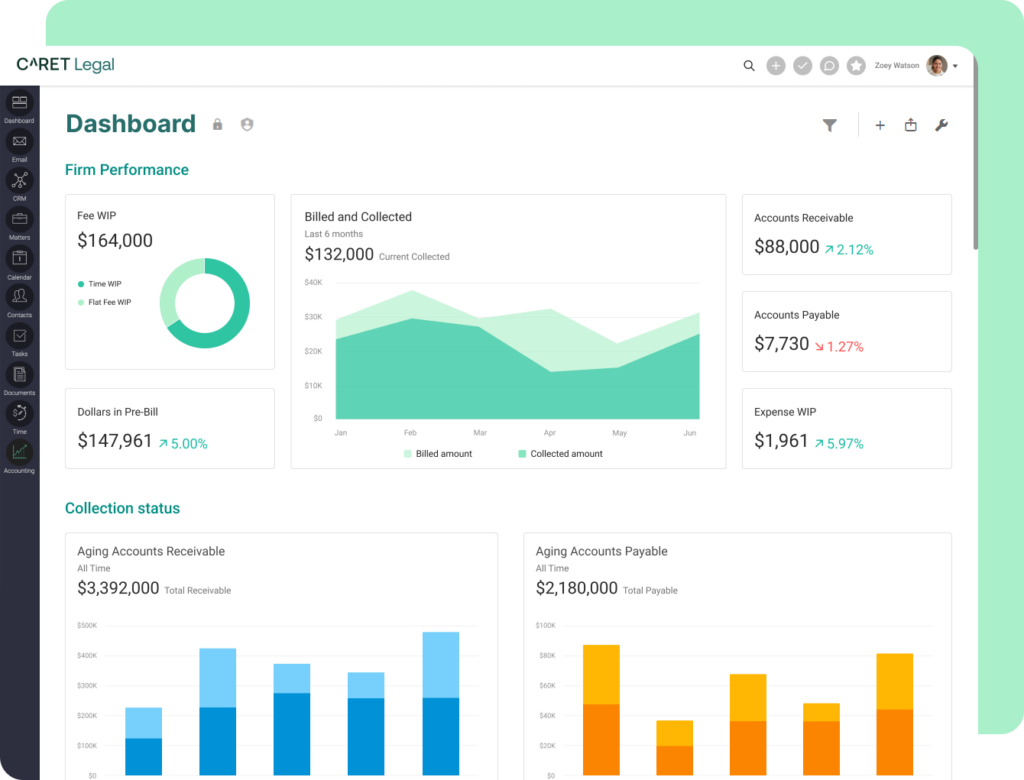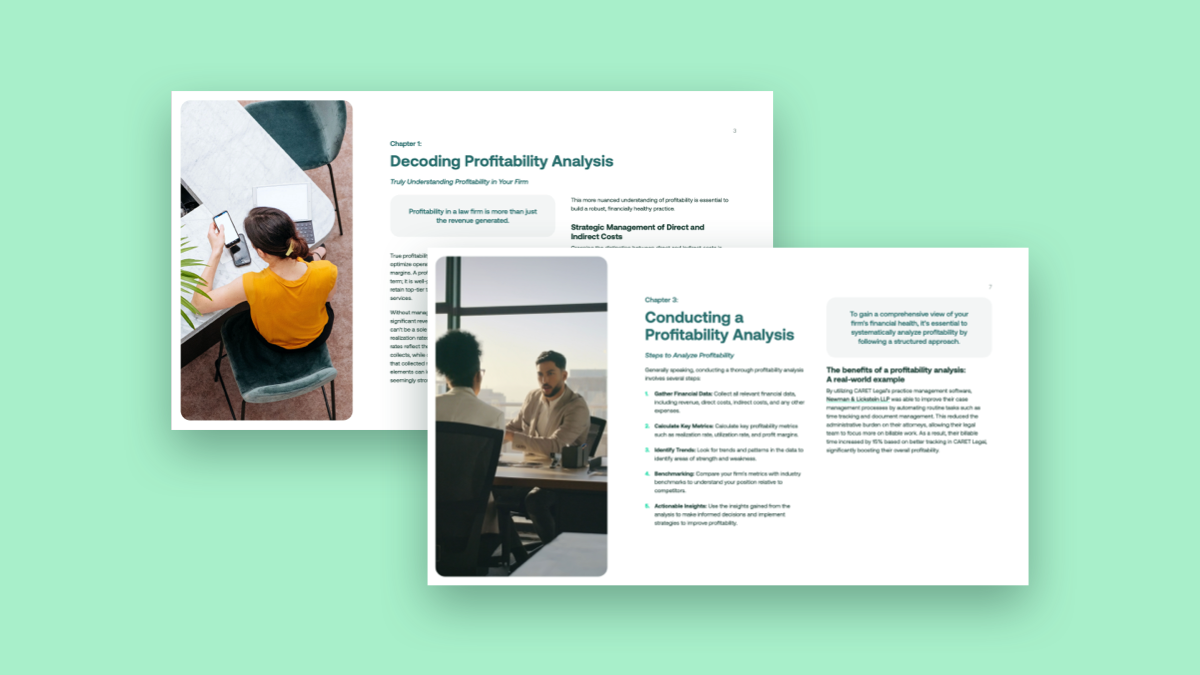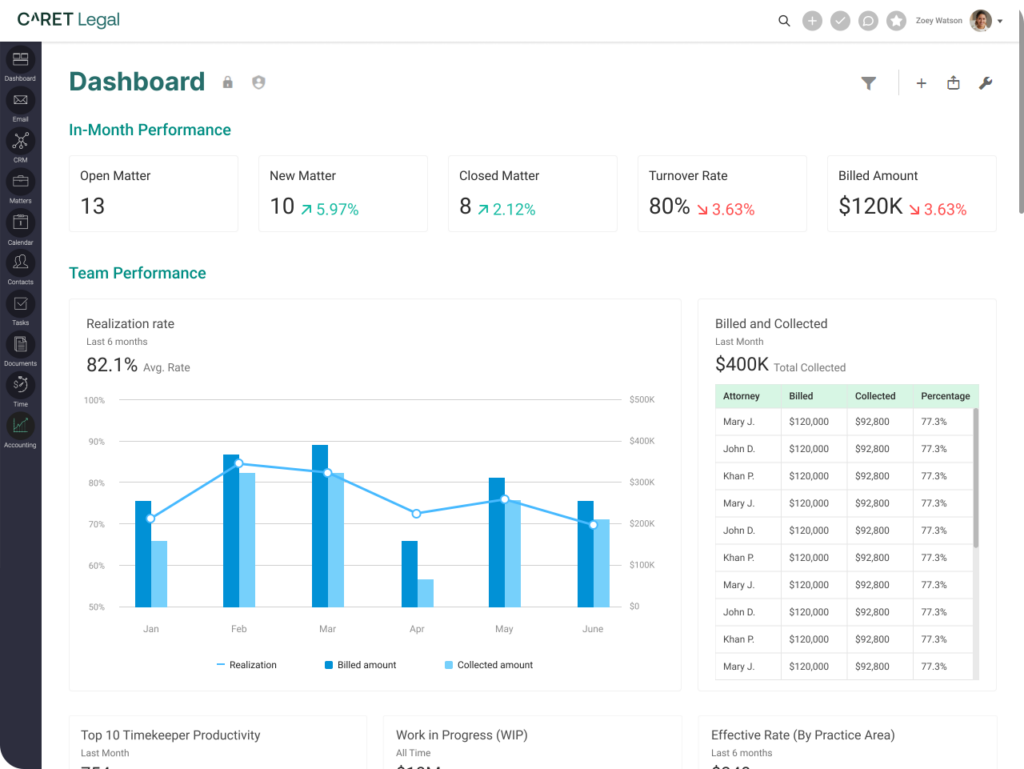Legal analytics provides actionable insights that help optimize workflows, enhance client relationships, and boost overall firm performance.
The ability to harness data analytics is rapidly becoming a key differentiator for law firms. With vast amounts of data generated from case management, billing, and client communications, firms are shifting away from intuition-based decision-making and making data-driven decisions to improve their operations. Legal analytics provides actionable insights that help optimize workflows, enhance client relationships, and boost overall firm performance. This blog will explore how law firms can use legal data analysis to improve decision-making, increase efficiency, and remain competitive in an ever-demanding industry.
Understanding Legal Data Analytics
Data analytics refers to the process of gathering, analyzing, and interpreting data to generate actionable insights. In the legal industry, legal analytics applies to data from a variety of sources, including case management systems, billing software, and client communications. However, this raw data alone is not enough to inform strategy; analytics tools are required to transform this data into actionable insight. Law firms can use these insights to improve decision-making and identify trends that may otherwise go unnoticed.
For example, a firm that tracks the time spent on each case can analyze which types of cases take the most time and resources. This information allows the firm to make more informed staffing decisions, better allocate resources, and adjust fees based on actual data rather than assumptions.

Tracking Law Firm Performance Metrics
Some of the most important law firm performance metrics to track when prioritizing data-driven decision-making are:
- Billable Hours: This helps ensure that attorneys are maximizing their time on productive, revenue-generating tasks. By tracking the ratio of billable to non-billable hours, firms can identify inefficiencies and optimize workflows.
- Case Completion Rates: Understanding how long cases take to complete helps identify bottlenecks in the process and highlights areas where resources may need to be reallocated. Consistently tracking this metric allows firms to streamline case workflows.
- Client Acquisition Costs: Monitoring how much it costs to acquire new clients provides insight into the effectiveness of marketing and business development strategies. Reducing acquisition costs while maintaining quality clients leads to more sustainable growth.
Real-time tracking of this data provides law firms with immediate insights into their performance, allowing them to make proactive adjustments. Using real-time data analytics, firms can:
- Adjust workloads dynamically to prevent bottlenecks
- Reallocate resources to high-demand practice areas
- Respond quickly to client needs or case developments
Understanding the Full Picture of Profitability at Your Firm
Understanding and accurately measuring firm profitability can be the difference between a thriving practice and one that struggles to keep its doors open. Download our eBook to learn how to identify and analyze key performance indicators, optimize pricing strategies, and improve resource allocation.

Enhancing Case Management Efficiency
Legal analytics can significantly improve case management by identifying bottlenecks in workflows and predicting potential case outcomes. By analyzing past cases, firms can improve future strategies and allocate resources more efficiently. For instance, data may reveal that certain types of cases tend to encounter delays at specific stages, such as document review or client communication. With this information, firms can streamline their processes to reduce delays and allocate resources where they are needed most.
Improving Client Acquisition and Retention
Data analytics enables law firms to better understand client acquisition patterns, satisfaction levels, and retention rates by analyzing specific client behaviors and preferences. This insight allows firms to refine their marketing strategies, target the right clients, and improve the overall client experience.
For example, a firm might analyze data from its intake process to determine which marketing channels—such as referrals, online ads, or social media—generate the most valuable leads. This allows the firm to invest more strategically in those channels, reducing acquisition costs while focusing on clients that provide the highest long-term value. Furthermore, data analytics can track client satisfaction by monitoring feedback, case outcomes, and billing preferences. If a particular practice area consistently sees low client retention, firms can use these insights to address service gaps, such as improving communication or offering flexible payment options.
With real-time insights, firms can identify bottlenecks, make more accurate predictions, and enhance both client acquisition and retention strategies
Optimizing Legal Billing and Financial Management
Billing is a crucial area where legal analytics can make a significant impact. Analyzing billing data allows firms to identify revenue gaps, track payment trends, and reduce late payments. Firms can also refine their billing structures by analyzing historical billing patterns and client preferences, whether through alternative fee arrangements or adjustments to hourly billing rates.
For example, a firm that consistently struggles with late payments might use law firm data to identify clients with slow payment histories and adjust billing practices for those clients, such as requesting up-front payments or offering installment plans. Data analytics also aids in financial forecasting, helping firms predict future revenue streams and control expenses more effectively.
Leveraging Predictive Analytics for Better Decision-Making
Predictive analytics allows law firms to forecast case outcomes, costs, and timeframes by analyzing historical data and identifying patterns. This data-driven approach enhances decision-making by providing legal teams with insights that would be difficult to predict through traditional methods.
For instance, predictive models can assist in litigation strategy by estimating the probability of winning a case based on factors such as past rulings, the judge’s history, or the strength of evidence. Firms can use these insights to decide whether to pursue litigation or opt for settlement, making their strategies more data-informed.
In case budgeting, predictive analytics can forecast how long a case may take and estimate its overall costs. This helps firms provide more accurate quotes to clients, avoid budget overruns, and ensure efficient resource allocation.

Data-Driven Compliance and Risk Management
Maintaining compliance with legal and regulatory requirements is another area in which data analytics can play a crucial role. By continuously monitoring key compliance metrics, firms can detect and address potential issues before they escalate. For example, analytics tools can track financial transactions to ensure that trust accounts are properly managed, helping firms avoid costly penalties.
Analytics can also identify patterns and trends in areas like client engagements, case management, and billing. This allows firms to predict and mitigate risks, such as billing inconsistencies or workflow bottlenecks, which could lead to disputes or inefficiencies.
Audit trails created through data analytics help maintain firm-wide accountability. With a detailed record of every action taken on cases and financial transactions, firms can easily demonstrate compliance and uphold transparency, especially during audits or in the case of client disputes.
Implementing Data Analytics Tools in Your Firm
Law firms have access to a wide range of data analytics tools, from case management software with built-in reporting features to dedicated financial dashboards that track billing, revenue, and productivity. These tools help firms get a clearer picture of their performance and make smarter decisions.
Integrating these analytics tools with existing systems – like document management or billing software – makes it easier to collect and analyze data without adding extra steps to daily operations. However, even with integration with current systems, training staff to interpret the data and insights generated by analytics tools is still crucial.
Adopting a Data-Driven Approach Allows For Efficiency and Growth
Adopting a data-driven approach not only improves operational efficiency but also gives your firm the competitive edge it needs to thrive in a demanding legal landscape. With real-time insights, firms can identify bottlenecks, make more accurate predictions, and enhance both client acquisition and retention strategies. Data-driven decision-making leads to more efficient resource allocation, better compliance management, and improved overall performance for both attorneys and clients.
